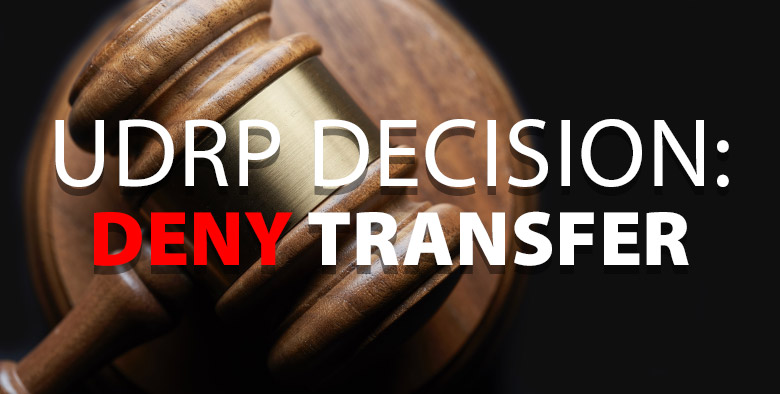The domain TopEmployers.com was registered in 1999 and CRF International Holding B.V., Netherlands, attempted to usurp it using a trademark for TOP EMPLOYERS INSTITUTE registered 20 years later.
The sole panelist at the WIPO pointed out exactly that huge gap between the domain’s registration and the mark, ordering the domain TopEmployers.com to remain with the Respondent.
The disputed domain name was registered twenty years prior to the registration of the TOP EMPLOYERS INSTITUTE trademark and is composed of two dictionary words – “top” and “employers”. It appears to the Panel that this combination can be legitimately used in connection with its dictionary meaning and without trading off the trademark rights of the Complainant. The Complainant does not claim to have existed in 1999, when the disputed domain name was registered, and does not provide any evidence about the extent of renown of its trademark at this time or at any time prior to its first trademark registration in 2019. The Complainant’s domain name was registered in 2009, which is ten years after the registration of the disputed domain name. The Complainant has not explained how the Respondent could have registered the disputed domain name in bad faith in light of these circumstances.
If this didn’t deserve to be a case of Reverse Domain Name Hijacking, we don’t know what would.

The domain transfer was denied.
Copyright © 2025 DomainGang.com · All Rights Reserved.ARBITRATION AND MEDIATION CENTER – ADMINISTRATIVE PANEL DECISION
CRF International Holding B.V. v. ThrottleUp Marketing LLC Case No. D2022-1056
The Parties
The Complainant is CRF International Holding B.V., Netherlands, represented by Novagraaf Nederland B.V., Netherlands.
The Respondent is ThrottleUp Marketing LLC, United States of America (“United States”).
The Domain Name and Registrar
The disputed domain name topemployers.com is registered with Domain.com, LLC (the “Registrar”).
Procedural History
The Complaint was filed with the WIPO Arbitration and Mediation Center (the “Center”) on March 28, 2022. On March 28, 2022, the Center transmitted by email to the Registrar a request for registrar verification in connection with the disputed domain name. On March 28, 2022, the Registrar transmitted by email to the Center its verification response disclosing registrant and contact information for the disputed domain name which differed from the named Respondent and contact information in the Complaint. The Center sent an email communication to the Complainant on March 29, 2022 providing the registrant and contact information disclosed by the Registrar, and inviting the Complainant to submit an amendment to the Complaint. The Complainant filed an amended Complaint on April 1, 2022.
The Center verified that the Complaint together with the amended Complaint satisfied the formal requirements of the Uniform Domain Name Dispute Resolution Policy (the “Policy” or “UDRP”), the Rules for Uniform Domain Name Dispute Resolution Policy (the “Rules”), and the WIPO Supplemental Rules for Uniform Domain Name Dispute Resolution Policy (the “Supplemental Rules”).
In accordance with the Rules, paragraphs 2 and 4, the Center formally notified the Respondent of the Complaint, and the proceedings commenced on April 5, 2022. In accordance with the Rules, paragraph 5, the due date for Response was April 25, 2022. The Respondent did not submit any response. Accordingly, the Center notified the Respondent’s default on May 2, 2022.
The Center appointed Assen Alexiev as the sole panelist in this matter on May 9, 2022. The Panel finds that it was properly constituted. The Panel has submitted the Statement of Acceptance and Declaration of
Impartiality and Independence, as required by the Center to ensure compliance with the Rules, paragraph 7.
Factual Background
The Complainant provides various services in the field of business and database management in addition to educational and certification services. It has 11 offices worldwide and has certified 1,857 companies as excelling in their roles as employers.
The Complainant is the owner of the following trademark registrations for the sign TOP EMPLOYERS INSTITUTE (the “TOP EMPLOYERS INSTITUTE trademark”):
− the Benelux trademark TOP EMPLOYERS INSTITUTE with registration No. 1392135, registered on June 5, 2019 for services in International Classes 35, 41, and 42;
− the International trademark TOP EMPLOYERS INSTITUTE with registration No. 1532814, registered on April 14, 2020 for services in International Classes 35, 41, and 42; and
− the United Kingdom trademark TOP EMPLOYERS INSTITUTE with trademark No. UK00801532814, registered on October 15, 2020 for services in International Classes 35, 41, and 42.
The Complainant is also the owner of the domain name top-employers.com, registered on January 13,
2009, which resolves to the Complainant’s official website.
The disputed domain name was registered on October 19, 1999. It resolves to a parking webpage and contains pay-per-click (“PPC”) links.
Parties’ Contentions
Complainant
The Complainant submits that the disputed domain name is confusingly similar to its TOP EMPLOYERS INSTITUTE trademark, because it incorporates a substantial part of this trademark.
According to the Complainant, the Respondent has no rights or legitimate interests in respect of the disputed domain name. The Complainant maintains that it has used the TOP EMPLOYERS INSTITUTE brand intensively in commerce for many years and continues to do so. According to the Complainant, the use of the disputed domain name is meant to exploit the reputation of the Complainant’s trademark and to use it for commercial gain, because the Respondent has parked the undeveloped disputed domain name through a parking service to gain monetary benefits, based on the traffic on the website. The Complainant states that as the disputed domain name does not refer to a functioning website it shows that the Respondent does not have a legitimate interest in respect to this. The Complainant notes that the Respondent has registered the disputed domain name in 1999, a reasonably long time to be able to develop a website and acquire a legitimate interest in respect of the disputed domain name.
According to the Complainant, the Respondent does not own any rights to a “top employers” trademark and has no relationship with the Complainant, who has not given any license to the Respondent to use the Complainant’s trademark in the disputed domain name. According to the Complainant, the Respondent falsely creates the impression that the disputed domain name belongs to the Complainant. The Complainant adds that Internet users will be misled and assume that the websites are affiliated to each other or that the website under the disputed domain name is also owned by the Complainant. In the Complainant’s view, since there is no commercial link between the owner of the disputed domain name and the Complainant, this tarnishes the TOP EMPLOYERS INSTITUTE trademark of the Complainant and is therefore unlawful against it.
The Complainant contends that the disputed domain name was registered and is being used in bad faith. According to it, the use and registration of the disputed domain name by the Respondent is in bad faith, as the Respondent has not used and is still not using it.
The Complainant adds that the Respondent’s use of the disputed domain name could not constitute a bona fide offering of goods or services pursuant to paragraph 4(c)(i) of the Policy. The Complainant notes that the look and feel of the website under the disputed domain name is quite similar to the look and feel of the website of the Complainant since both websites use the same font for the texts, always in white letters and have big identically shaped buttons for redirecting to other components on the website. The Complainant states that the Respondent is trying to imitate the Complainant with the contents of its website as well which misleads the consumer and causes even more confusion. The Complainant concludes that the Respondent intentionally causes initial interest confusion and intentionally attempts to attract customers to its website for commercial gain. In the Complainant’s view, even if a visitor of the Respondent’s websites were to realize that he or she had been redirected to another website unconnected with the Complainant, nonetheless the initial interest confusion that lured the visitor in would also support a finding of bad faith.
Respondent
The Respondent did not reply to the Complainant’s contentions.
Discussion and Findings
Pursuant to the Policy, paragraph 4(a), the Complainant must prove each of the following to justify the transfer of the disputed domain name:
the disputed domain name is identical or confusingly similar to a trademark or service mark in which the Complainant has rights;
the Respondent has no rights or legitimate interests in respect of the disputed domain name; and
the disputed domain name was registered and is being used in bad faith.
Identical or Confusingly Similar
The Complainant has provided evidence of the registration of the TOP EMPLOYERS INSTITUTE trademark and has thus established its trademark rights for the purposes of the Policy. This trademark was first registered only in 2019, which is twenty years after the registration of the disputed domain name. As discussed in section 1.1.3 of the WIPO Overview of WIPO Panel Views on Selected UDRP Questions, Third Edition (“WIPO Overview 3.0”), the Policy makes no specific reference to the date on which the holder of the trademark or service mark acquired its rights, but such rights must be in existence at the time the complaint is filed, and the fact that a domain name may have been registered before a complainant has acquired trademark rights does not by itself preclude a complainant’s standing to file a UDRP case, nor a panel’s finding of identity or confusing similarity under the first element. However, where a domain name has been registered before a complainant has acquired trademark rights, only in exceptional cases would a complainant be able to prove a respondent’s bad faith. This is discussed in the following sections of the present decision.
The Panel notes that a common practice has emerged under the Policy to disregard in appropriate circumstances the generic Top-Level Domain (“gTLD”) section of domain names for the purposes of the first element comparison under the Policy, paragraph 4(a)(i). See section 1.11.1 of the WIPO Overview 3.0. The Panel sees no reason not to follow the same approach here, so it will disregard the “.com” gTLD section of the disputed domain name.
The relevant part of the disputed domain name is therefore the element “topemployers”, which reproduces the first two words of the TOP EMPLOYERS INSTITUTE trademark. The Panel regards this as sufficient to make the trademark recognizable in the disputed domain name.
Therefore, the Panel finds that the disputed domain name is confusingly similar to the TOP EMPLOYERS INSTITUTE trademark in which the Complainant has registered trademark rights.
Rights or Legitimate Interests
As long as the Complainant has failed to establish that the disputed domain name has been registered and is being used in bad faith, there is no need to address the issue of whether the Respondent has rights or legitimate interests in the disputed domain name.
Registered and Used in Bad Faith
As summarized in section 3.8.1 of the WIPO Overview 3.0, where a respondent registers a domain name before the complainant’s trademark rights accrue, panels will not normally find bad faith on the part of the respondent.
The disputed domain name was registered twenty years prior to the registration of the TOP EMPLOYERS INSTITUTE trademark and is composed of two dictionary words – “top” and “employers”. It appears to the Panel that this combination can be legitimately used in connection with its dictionary meaning and without trading off the trademark rights of the Complainant. The Complainant does not claim to have existed in 1999, when the disputed domain name was registered, and does not provide any evidence about the extent of renown of its trademark at this time or at any time prior to its first trademark registration in 2019. The Complainant’s domain name was registered in 2009, which is ten years after the registration of the disputed domain name. The Complainant has not explained how the Respondent could have registered the disputed domain name in bad faith in light of these circumstances.
While it is possible that the disputed domain name changed hands subsequent to the Complainant’s commencement of business activities or trademark registration, the Complainant has not presented any evidence (if it would be available, e.g. through a detailed search report) or made any arguments to this effect, and no change is apparent from the WhoIs records or otherwise. Moreover, contrary to the Complainant’s allegations, the parking webpage to which the disputed domain name resolves does not appear as similar to the Complainant’s website. In view of the above, based on the facts before the Panel, there is no evidence that the Respondent knew of the Complainant at the time when it registered the disputed domain name or targeted it with this registration. Therefore, the Panel concludes that the Complainant has failed to establish that the Respondent has registered the disputed domain name in bad faith.
The Policy requires the Complainant to establish that the Respondent has both registered and used the disputed domain name in bad faith. Since the Complainant has failed to establish bad faith registration, the Complaint must fail, and it is not necessary to decide whether the disputed domain name has been used in bad faith.
Decision
For the foregoing reasons, the Complaint is denied.
/Assen Alexiev/ Assen Alexiev Sole Panelist
Date: May 23, 2022












